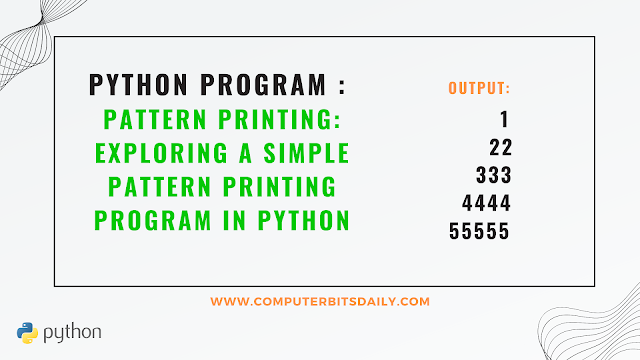Are you looking to add some fun and creativity to your Python programming skills? In this blog post, we will explore an exciting Python program that prints a unique pattern. This pattern is not only visually appealing but also provides an excellent opportunity to practice loops and conditional statements in Python. Whether you are a beginner or an experienced programmer, this program will help enhance your problem-solving skills and make your code stand out. So, let's dive into the world of pattern printing with Python!
Table of Contents:- Understanding the Pattern
- Writing the Python Code
- Exploring the Code
- Running the Program
Understanding the Pattern
Before we start writing our Python code, let's understand the pattern we want to print. The desired pattern is as follows:
1
22
333
4444
55555
Writing the Python Code:
Now, let's write the Python code to print the pattern. Open your preferred Python integrated development environment (IDE) or text editor and create a new Python file. You can name it "pattern_printing.py" or choose any other suitable name.# pattern_printing.pydef print_pattern(rows):for i in range(1, rows + 1):spaces = ' ' * (rows - i)numbers = str(i) * iprint(spaces + numbers)# Main programif __name__ == "__main__":rows = 5 # Change this value to print more or fewer rowsprint_pattern(rows)
| Practice Python MCQ with "Python MCQ Programs Interview " Android App.
Exploring the Code:
Let's break down the code to understand how it works:- We define a function called print_pattern that takes the number of rows as a parameter.
- Inside the function, we use a for loop to iterate from 1 to the number of rows specified.
- In each iteration, we calculate the number of spaces using the formula spaces = ' ' * (rows - i).
- We generate the numbers for each row by multiplying the current row number (i) with a string representation of i: numbers = str(i) * i.
- Finally, we print the combination of spaces and numbers using the print statement.
- Inside the function, we use a for loop to iterate from 1 to the number of rows specified.
- In each iteration, we calculate the number of spaces using the formula spaces = ' ' * (rows - i).
- We generate the numbers for each row by multiplying the current row number (i) with a string representation of i: numbers = str(i) * i.
- Finally, we print the combination of spaces and numbers using the print statement.
Running the Python Program:
To run the program, save the file and execute it using your preferred Python interpreter or by running the command python pattern_printing.py in your terminal or command prompt. The program will print the desired pattern based on the number of rows specified.In this blog post, we explored an engaging Python program that prints a unique pattern. By understanding the pattern, writing the Python code, and running the program, we were able to create an eye-catching triangular pattern with numbers. This exercise provided an opportunity to improve our Python skills, such as using loops, conditional statements, and string manipulation.
So, what are you waiting for? Give this Python pattern printing program a try and explore other creative coding exercises to sharpen your skills. Happy coding!




0 Comments